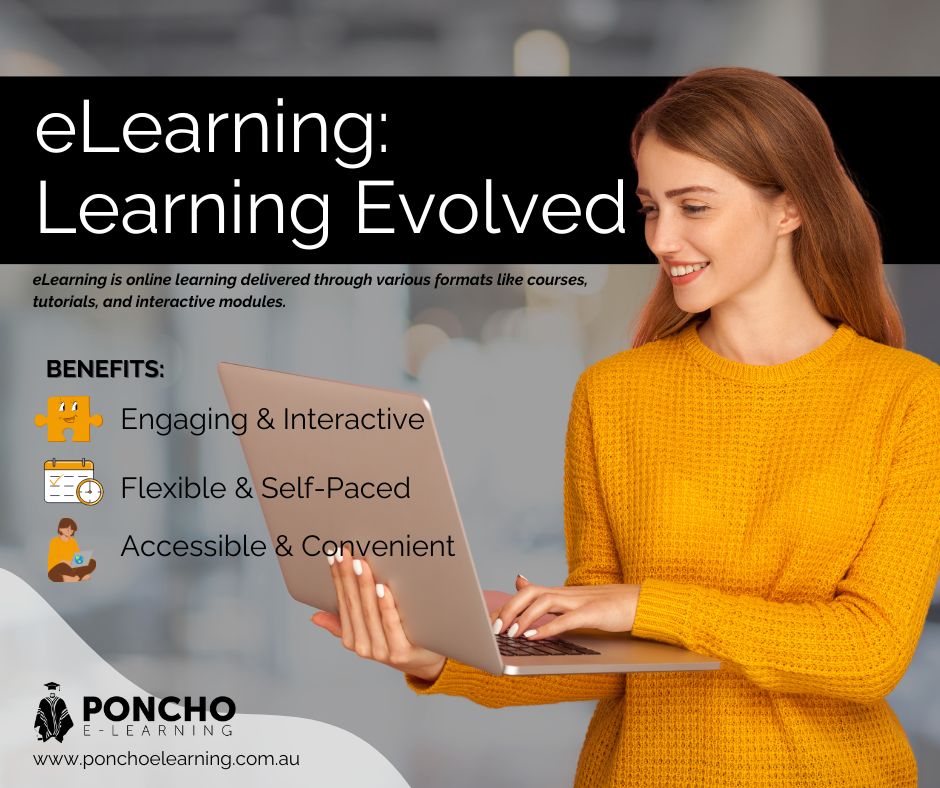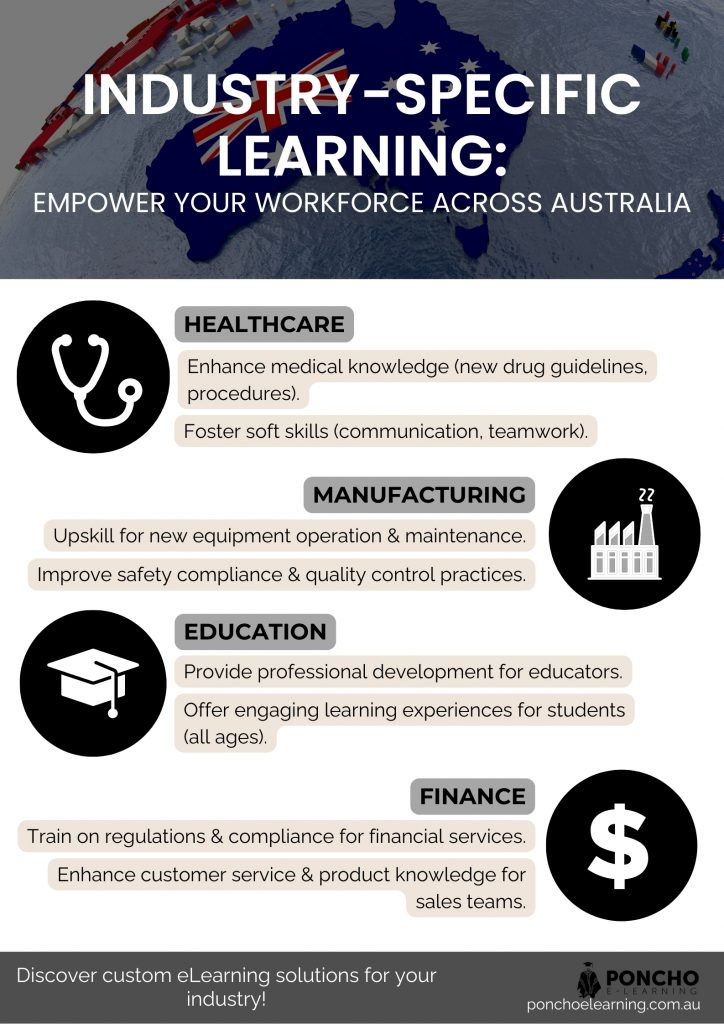ELearning content plays a pivotal role in modern workforce development. Its flexibility and efficiency in delivering training and upskilling opportunities make it a valuable tool for businesses across all industries. However, to truly maximise the impact of eLearning, tailoring the content to the specific needs of each industry sector is essential.

What is an eLearning service?
An eLearning service encompasses the design, development, delivery, and management of online learning experiences. These experiences can take diverse forms, including interactive modules, video tutorials, simulations, assessments, and gamified elements, all designed to facilitate, track, and measure learning outcomes.
By understanding the unique challenges, regulations, and learning preferences of each industry, eLearning developers can create engaging and effective programs that directly address the specific needs of the workforce. This targeted approach not only enhances learner motivation and knowledge retention but also leads to improved job performance, increased productivity, and overall business success.

Understanding the Australian context
Australia boasts a diverse and dynamic economy, encompassing various industry sectors, each with its own set of training requirements. Here are some key considerations for tailoring eLearning content for the Australian market:
Compliance with Australian regulations
Certain industries in Australia, such as healthcare and construction, operate under specific regulations and compliance requirements. eLearning content must be developed and delivered in accordance with these regulations to ensure the training adheres to legal and ethical standards.
For example, healthcare professionals might require training modules that comply with the Australian Commission on Safety and Quality in Health Care (ACSQHC) standards, while construction workers might need training aligned with the relevant Work Health and Safety (WHS) regulations specific to their state or territory.
Focus on cultural sensitivity
Australia is a multicultural nation with a diverse workforce. When developing eLearning content, it’s crucial to consider the cultural backgrounds and sensitivities of learners.
This includes using inclusive language, avoiding stereotypes, and incorporating culturally relevant examples and scenarios.
For example, using local references, case studies, and imagery that resonate with diverse audiences can enhance engagement and understanding.
Catering to varying technological skills
The level of technological proficiency can vary significantly across different generations and demographics within the Australian workforce.
ELearning content should be designed with user-friendliness in mind, utilising intuitive interfaces, responsive design, and offering accessible navigation options across various devices. This ensures inclusivity and empowers learners with diverse technological skill sets to access and successfully complete the training.
Beyond the Basics: Strategies for Tailoring eLearning Content
Tailoring eLearning content goes beyond simply adjusting the subject matter. Here are some additional strategies to consider:
Identify the target audience
Clearly define the specific roles, experience levels, and learning objectives of the target audience within the chosen industry sector. This will help create content that is relevant and addresses their specific needs.
Conduct needs analysis
Conduct research or surveys to understand the specific training needs, challenges, and knowledge gaps within the industry. This can involve interviews with subject matter experts, HR professionals, and potential learners themselves.
Choose the appropriate learning format
Consider the most effective format for delivering the content based on the industry context and learning objectives. This could involve interactive modules, branching scenarios, simulations, microlearning elements, or a combination of these formats.
Utilise multimedia elements
Integrate multimedia elements like videos, animations, infographics, and audio recordings to enhance engagement and cater to diverse learning styles. Visual representations of complex concepts and real-world scenarios can significantly improve understanding and knowledge retention.
Incorporate gamification
Consider incorporating gamification elements like points, badges, leaderboards, and rewards to boost learner engagement and motivation. This can be particularly effective for industries where employees typically deal with complex or repetitive tasks, as it fosters a sense of competition and accomplishment.
Localise the content
Tailor the language, examples, and references to the specific Australian context. This includes using Australian English, incorporating local statistics and case studies, and aligning with local regulations and industry standards.
Examples of Industry-Specific eLearning in Australia
By taking these factors into account, eLearning developers can create content that resonates with specific industry sectors. Here are some expanded examples of of how eLearning programs can be tailored to various Australian industries:
Healthcare
In the fast-paced and evolving healthcare sector, eLearning plays a critical role in keeping professionals updated on the latest medical research, best practices, and advancements in technology. Interactive modules can cover topics like:
- Patient safety: Simulations can be used to train on handling emergency situations and adhering to safety protocols.
- Clinical procedures: Step-by-step video tutorials and interactive simulations can demonstrate some medical procedures effectively.
- Mental health awareness: Interactive modules can equip healthcare professionals with skills and knowledge to identify and address mental health concerns in patients.
- Use of new technologies: Interactive tutorials can introduce and use of new technologies. Interactive tutorials can introduce and familiarise employees with the capabilities of emerging technologies like augmented reality (AR) and virtual reality (VR).
Manufacturing
The manufacturing industry relies heavily on skilled professionals operating complex machinery and adhering to strict safety protocols. eLearning programs can provide interactive training on topics like:
- Machine operation: 3D animations and interactive simulations can offer a safe and realistic environment to train on operating complex machinery, minimising risk and maximising learning impact.
- Maintenance procedures: Step-by-step video tutorials and interactive modules can guide workers on conducting routine maintenance tasks, ensuring equipment operates efficiently and safely.
- Safety regulations: Engaging modules can explain safety protocols, potential hazards, and proper safety equipment usage, fostering a culture of safety awareness within the workforce.
- Quality control: Interactive exercises and simulations can train workers on identifying and addressing potential quality issues, contributing to improved product quality and reduced waste.
- Emerging technologies: Interactive tutorials can introduce and explain new technologies like robotics, automation, and 3D printing, equipping workers with the necessary skills to adapt and thrive in a rapidly evolving industry.
Education
The education sector has embraced eLearning as a valuable tool for both teachers and students. Online courses can provide:
- Professional development: Teachers can access online courses on various topics, including curriculum implementation, instructional technology, and differentiated learning strategies, enhancing their teaching skills and effectiveness.
- Differentiated learning: Students with diverse learning styles and needs can benefit from personalised eLearning modules that adjust difficulty, pace, and content delivery based on individual progress and understanding.
- Interactive learning experiences: Gamified learning elements, simulations, and virtual reality experiences can enhance engagement and make learning more interactive and memorable for students.
- Remote learning: ELearning platforms can facilitate remote learning opportunities, allowing students to access educational materials and participate in online discussions regardless of their location.
Finance
In the ever-evolving financial services industry, eLearning helps professionals stay current with regulatory changes, new financial products, and emerging technologies. Interactive modules can cover topics like:
- Compliance regulations: Engaging simulations and quizzes can assess knowledge and ensure advisors and sales representatives fully understand complex regulations, like anti-money-laundering.
- Financial risk management: Interactive modules and case studies can equip professionals with the skills to identify, analyse, and mitigate financial risks, safeguarding the organisation and its clients.
- New financial products: Videos, simulations, and interactive presentations can introduce and explain new financial products and services, allowing professionals to confidently offer informed advice to clients.
- Customer service training: Interactive modules and role-playing simulations can train customer service representatives on effective communication skills, conflict resolution techniques, and best practices for building strong client relationships.
- Financial literacy: Gamified modules and interactive simulations can be used to educate clients on various financial topics, empowering them to make informed financial decisions.
Elearning presents a powerful tool for delivering effective training and upskilling opportunities across diverse Australian industries.
By tailoring the content to the specific needs and context of each sector, organisations can ensure their workforce has the necessary knowledge and skills to thrive in today’s competitive landscape.
By keeping the Australian context in mind, focusing on industry-specific needs, and implementing the strategies outlined in this article, eLearning developers can create engaging, effective, and impactful learning experiences that contribute to a skilled and productive Australian workforce.





